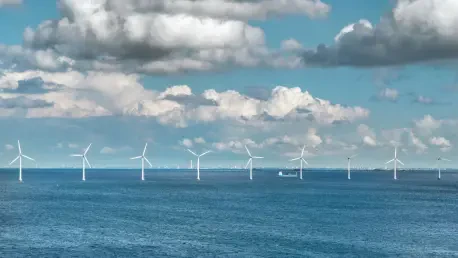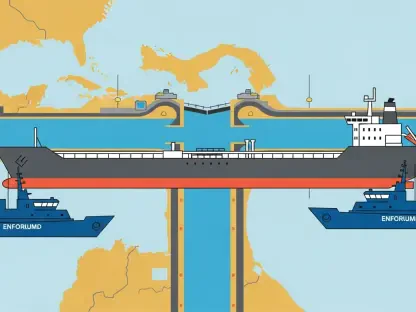In a striking blow to renewable energy ambitions on the East Coast, a massive offshore wind farm project off the coast of New Jersey has been abruptly terminated, casting a shadow over the state’s clean energy goals and raising serious doubts about the future of such initiatives. This development, involving the Leading Light Wind (LLW) initiative, was set to be a cornerstone of sustainable power generation, promising enough electricity to serve around a million homes. However, economic, regulatory, and political challenges have proven insurmountable, leading to the project’s cancellation. This setback is not just a singular event but a reflection of deeper systemic issues plaguing the offshore wind industry in the region. The implications of this decision ripple beyond state lines, raising questions about the viability of large-scale renewable projects in the face of mounting obstacles.
Challenges Facing Offshore Wind Initiatives
Economic and Supply Chain Hurdles
The termination of the LLW project highlights the severe economic pressures that offshore wind developers are grappling with in New Jersey. Planned to generate 2.4 gigawatts of electricity, this ambitious endeavor faced relentless supply chain disruptions and equipment shortages that drove costs to unsustainable levels. Developers Invenergy and energyRe encountered persistent issues with vendors, making it nearly impossible to secure the necessary components on time. These challenges were compounded by broader industry trends, where inflation and global supply bottlenecks have strained budgets for renewable energy projects. The economic landscape has shifted dramatically, rendering initial financial projections obsolete and forcing tough decisions. Even with a renewable energy certificate awarded by state regulators, the numbers simply did not add up, leaving the project without a viable path forward. This scenario underscores how fragile the balance is between ambition and feasibility in the renewable sector, where external market forces can derail even the most promising initiatives.
Beyond the supply chain woes, the economic viability of offshore wind projects like LLW has been further undermined by fluctuating energy markets and investment uncertainties. Securing funding for such large-scale infrastructure requires long-term stability, which has been elusive amid rising interest rates and shifting investor priorities. The developers faced additional hurdles in aligning their timelines with market demands, as delays in procurement led to missed milestones and eroded confidence. Moreover, the cost of adapting to new technological standards and safety requirements added unforeseen expenses, pushing the project further into the red. This situation is emblematic of a broader struggle within the industry, where the promise of clean energy often clashes with the harsh realities of financial constraints. The collapse of this initiative serves as a cautionary tale for other states and developers aiming to scale up offshore wind capacity without a robust economic safety net.
Regulatory and Permitting Obstacles
Navigating the regulatory maze has proven to be another formidable barrier for the LLW project, ultimately contributing to its downfall. The developers struggled to obtain critical federal permits, a process mired in complexity and subject to shifting political winds. Evolving regulatory requirements demanded constant adaptation, adding layers of bureaucracy that slowed progress to a crawl. Each new mandate or guideline required reevaluation of plans, further inflating costs and timelines. State and federal oversight, while necessary for environmental and safety reasons, often clashed with the urgent need for swift project implementation. This regulatory quagmire created a bottleneck that the project could not overcome, despite initial approvals and support from local authorities. The frustration of dealing with an ever-changing framework is a common theme among renewable energy developers, pointing to a need for streamlined processes if such projects are to succeed.
Adding to the regulatory challenges, the political climate at the federal level introduced further uncertainty for offshore wind initiatives in New Jersey. Policies and priorities can shift with administrations, and the stance on renewable energy has not always been favorable. For LLW, this meant facing potential delays or outright denials of permits critical to moving forward. Legal counsel for the project formally notified state regulators that continuing under the current framework was no longer feasible, citing these permitting issues as a key factor. The inability to secure timely approvals reflects a broader tension between environmental goals and administrative realities. This struggle highlights how dependent offshore wind projects are on a stable and supportive regulatory environment, without which even well-planned initiatives can falter. The experience of LLW suggests that future projects may need stronger governmental collaboration to navigate these obstacles effectively.
Broader Implications for Renewable Energy
Statewide Setbacks in Clean Energy Goals
The cancellation of LLW is not an isolated incident but part of a troubling pattern of setbacks for New Jersey’s offshore wind ambitions. Other significant projects, such as Atlantic Shores and Ocean Wind, have also been derailed, leaving nearly all of the state’s offshore wind contracts defunct. The sole surviving initiative, Empire Wind, is contracted to supply power to a neighboring state, offering little direct benefit to New Jersey’s energy grid. This wave of cancellations paints a grim picture of an industry in crisis, where systemic issues like economic pressures and regulatory uncertainties consistently undermine progress. The loss of these projects represents a major step backward in the state’s pursuit of sustainable energy, raising concerns about meeting long-term carbon reduction targets. It also signals to investors and policymakers that the path to renewable energy is fraught with risks, potentially discouraging future investment in the sector.
The ripple effects of these cancellations extend to public perception and trust in renewable energy initiatives. Communities that were promised economic benefits, such as job creation and lower energy costs, now face disappointment and skepticism. The repeated failure to deliver on ambitious projects like LLW erodes confidence in government and industry commitments to a greener future. Additionally, the absence of operational offshore wind farms delays the transition from fossil fuels, prolonging reliance on less sustainable energy sources. This situation places New Jersey at a disadvantage compared to other regions that have successfully implemented offshore wind projects. Addressing these statewide setbacks will require a concerted effort to rebuild trust, reassess economic models, and prioritize actionable solutions over ambitious but unfeasible plans. Without such measures, the state’s clean energy aspirations remain at risk of becoming mere rhetoric.
Political Resistance and Future Prospects
Political opposition has emerged as a significant barrier to offshore wind development along New Jersey’s coast, further complicating the industry’s future. In recent elections, coastal areas—where resistance to such projects is often strongest—showed substantial support for candidates opposed to offshore wind. This sentiment, fueled by concerns over visual impacts, environmental effects, and economic burdens, has created a hostile environment for developers. High-profile political figures have capitalized on this discontent, campaigning against renewable projects and amplifying public dissent. Such opposition not only influences policy decisions but also shapes the narrative around offshore wind, making it harder to garner the widespread support needed for success. This political landscape adds another layer of complexity to an already challenging field, where public opinion can sway project outcomes as much as economic or regulatory factors.
Looking ahead, the prospects for offshore wind in New Jersey appear dim under current conditions, though glimmers of hope persist. Developers have expressed regret over cancellations like LLW, hinting at potential future opportunities if economic and political climates improve. However, without concrete strategies to address supply chain issues, streamline permitting processes, or counter political resistance, revival remains unlikely. The industry’s path forward hinges on collaborative efforts between state and federal governments to create a more supportive framework. Incentives for investment, public education campaigns to shift opinion, and innovative financing models could help turn the tide. Reflecting on the past, it’s evident that the collapse of major projects stemmed from a confluence of challenges that were not adequately anticipated or mitigated. Moving forward, stakeholders must learn from these missteps, focusing on pragmatic solutions and building resilience against the economic and political headwinds that derailed progress.









